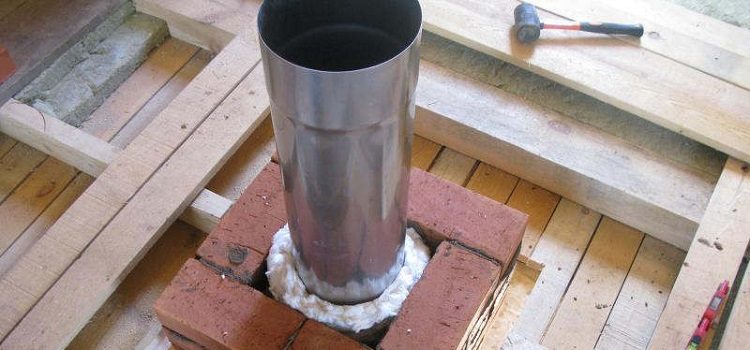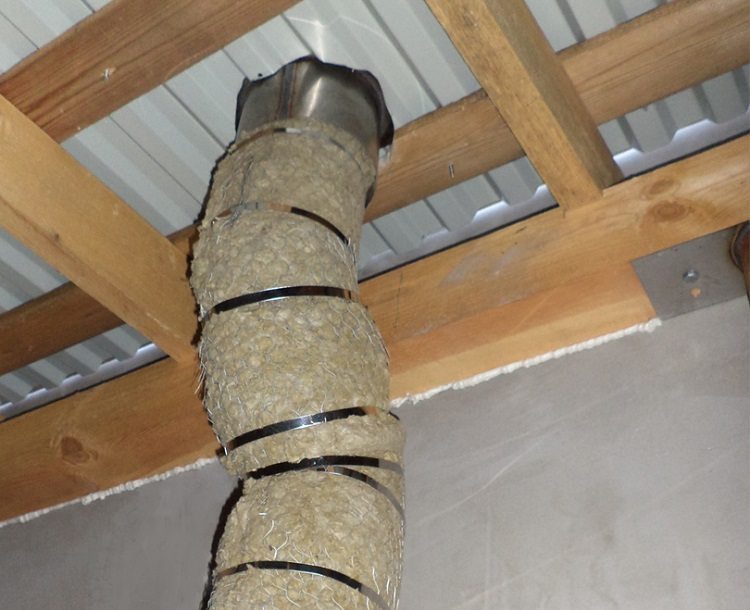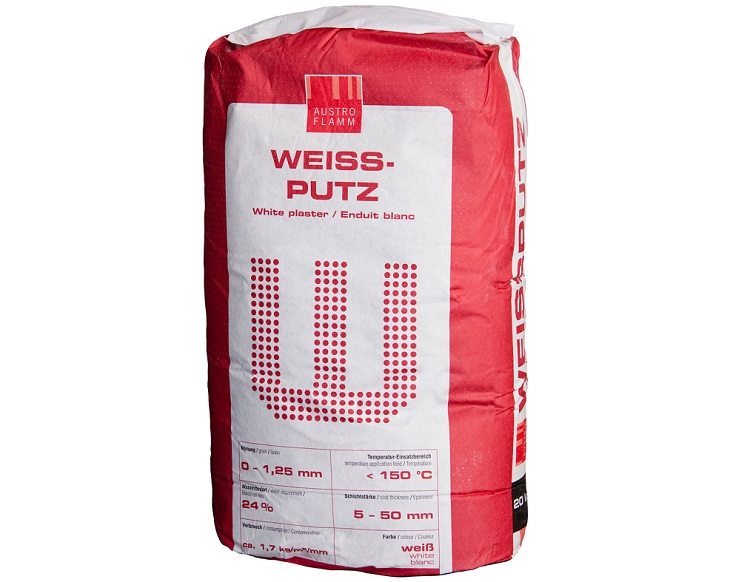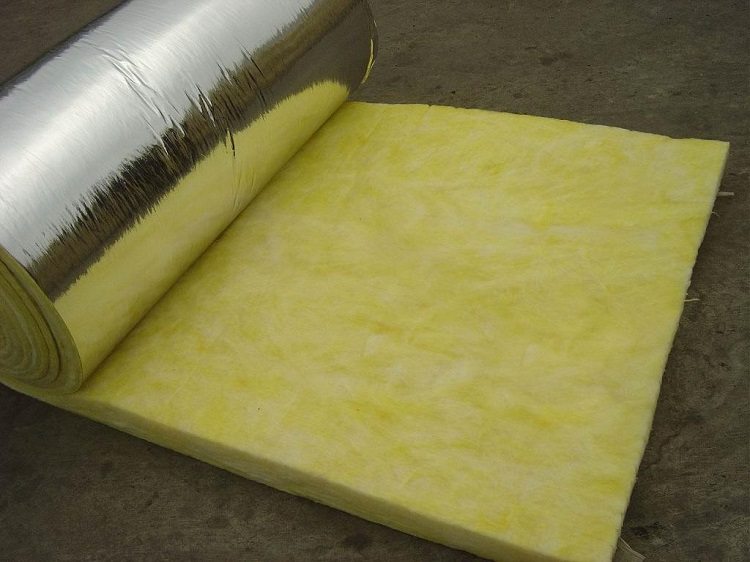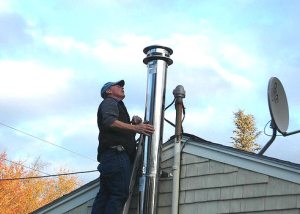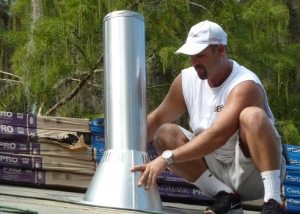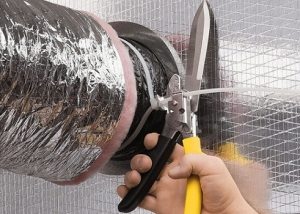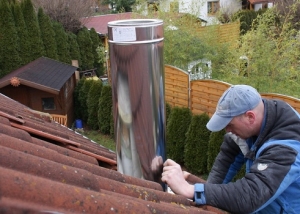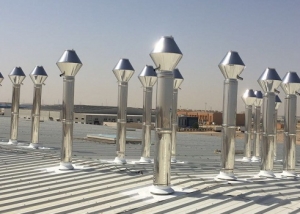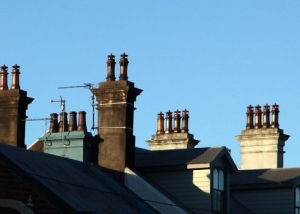When arranging a fireplace or stove in a private house or in the country, the question often arises of how and how to insulate the metal chimney pipe with your own hands. Properly performed insulation of the chimney is important from the point of view of fire safety and protecting the roof from leaks. It is advisable to consider the scheme according to which the chimney will be insulated, even at the construction design stage. Isolation of a finished chimney system is not always possible without changing the roof structure.
Content
Causes of damage to the chimney
Poor insulation or its complete absence leads to premature destruction of the chimney. There are several reasons that especially affect the integrity and functionality of the chimney:
- Dampness. In the chimney system there is an increased and, most importantly, constant humidity. This is not surprising, despite the fact that the chimney is in fact a warm place. Moisture transported together with warm air vapor partially settles on the walls of the chimney, forming condensate.
- The effect of aggressive chemicals. At the time of fuel combustion, a huge amount of active substances is released. Among them, caustic acids dangerous to human life: sulfuric, carbonic, nitric. When the chimney is functioning, almost all decay products exit along with the air stream. During the inactivity of the chimney system, these substances accumulate on the walls of the pipe, equally quickly destroying both metal and brick.
By insulating the chimney pipe, it is possible to stop or prevent irreversible chemical processes that occur under the action of moisture and fuel decomposition products.
Untimely measures taken to protect the chimney can cause the destruction of the structure of the house. Condensate saturated with acids can slowly but intensely corrode building materials. Condensation becomes especially dangerous during thawing of pipes after the cold season.
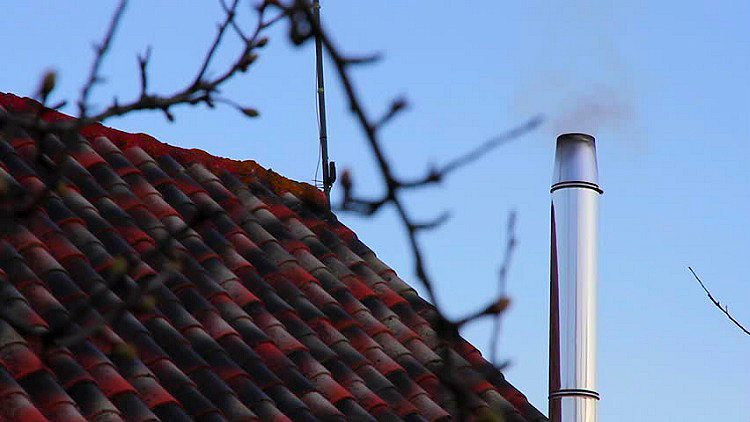
The smoke coming out of the chimney contains harmful substances that cause the destruction of the chimney
Benefits of chimney insulation
Chimney insulation is an effective tool against many destructive factors. Of course, the insulation of chimneys with their own hands will not be able to completely protect the system from the harmful effects of precipitation or wind. But it makes it possible to really extend the operational life of the pipe. This happens due to the following circumstances:
- Exclusion of the probability of condensation falling on the pipe wall saturated with aggressive acids. In this case, the products of fuel combustion simply disappear with a stream of smoke.
- Reducing temperature differences between hot steam and the chilled surface of the smoke channel.
- Creating an energy-saving effect. Properly insulated chimney pipes suffer less energy loss than pipes without insulation.This helps to save fuel used to maintain high temperature in the furnace.
- Improving the strength of the chimney design. Thanks to the insulation, which plays the role of a reinforcing frame, the chimney becomes more resistant to gusts of wind.
Properly selected insulation can increase the frost-resistant qualities of the system. The negative effect of high temperatures on the roof sections located around the chimney is partially eliminated. This allows for a long time to delay the repair of the roof itself. The insulated system has high aesthetic qualities, since insulation contributes to the long-term preservation of the original appearance of the pipe.
What is better to insulate a metal chimney pipe?
If pipe insulation is done with your own hands, it is necessary to take into account the fact that the heating temperature of the system can be very high - up to 200-300 degrees. As a heater for chimney pipes, only a material completely devoid of flammability is suitable. These are various fibrous heaters, glass wool, mineral wool, slag concrete slabs. It is possible to isolate the chimney using plaster mortar. Stainless steel sleeves are also used to insulate sandwich type chimneys.
Helpful advice! The severity of the insulation must be commensurate with the withstanding ability of the roof. Insulation materials that are too heavy push the roof over time. Light materials, such as mineral wool, are best suited for laying insulation with your own hands.
Ready-made cylindrical heaters are on sale. They provide complete chimney protection and are equipped with a special foil screen. Heat-insulating tubular structures come in different diameters, so they can be used to insulate large-sized chimneys.
Do-it-yourself insulation features of metal pipes
Before you start to insulate a chimney steel pipe or any other metal pipe with your own hands, it is necessary to check the correct installation of the structure. The chimney must comply with all technological standards.
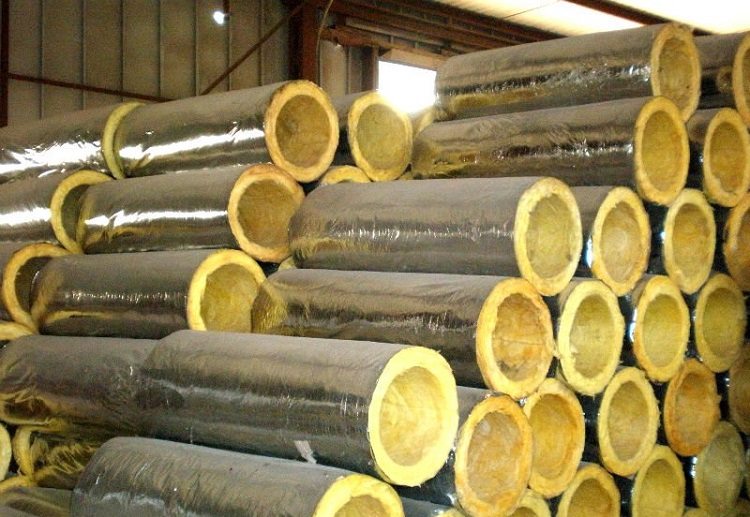
The easiest way is to insulate a metal chimney with an already finished “shell”, selected for the diameter of the pipe
The following requirements are presented:
- optimal traction in the system is achieved only if there is a pipe with a height of 5 meters or more;
- the distance between the pipe and the burning parts of the roof (floors, rafters) is at least 250 mm;
- if the roof structure includes combustible materials, namely slate, roofing material or ondulin, the insulated pipe is equipped with a special spark trap. It is a stainless steel mesh plate encircling the chimney at the top. To prevent debris getting into the spark arrester, the grid is covered with a metal “cap”.
Helpful advice! In the chimney system, the presence of a fire distance between the ceiling of the room and the upper stove floor is mandatory. In the case of metal furnaces, at least 1.5 meters of supply are taken.
Work on the winding of a metal chimney can begin after checking the system for any malfunctions. It is also worth making sure that only non-combustible materials were purchased for insulation. You should additionally familiarize yourself with the manufacturer's instructions on the insulation packaging.
Methods of insulation of a chimney made of metal
Chimneys of different types and designs require different methods of insulation. There are types of insulation depending on the purpose of the chimney.
How to wrap stove or chimney metal chimney pipes?
Steel chimneys can be used for decorative stoves and fireplaces that do not perform the function of a constant source of heating.It is enough to isolate such a chimney with a layer of plaster mortar. This method is mainly used for insulating chimneys from masonry, but a variation calculated for metal pipes is also possible.
The mixture is prepared from a special mixture and water. It will be technologically correct to first pour water into the container for stirring, and only then add the dry mixture there. After beating with a construction mixer, a homogeneous, dense mass should be obtained.
The solution is applied to the insulated surface with stains using a spatula. Lumps of the solution must be distributed evenly over the entire pipe area. These sections are needed to fix the reinforcing frame of the fiberglass mesh onto them. Without a framework, a thick layer of plaster may soon crack and become unusable.
First, a rough layer of plaster adjacent to the duct is applied to the reinforcing cage. After applying the main thickness of the plaster, you can form a finishing layer.
Helpful advice! The surface of the inner part of the chimney located in the attic can be isolated with your own hands using an alternative method. It consists in wrapping a chimney pipe with mineral wool panels. Flat panels are fixed on the pipe surface with masking tape. But this method of insulation is not acceptable for open sections of the chimney, since mineral wool loses its heat-resistant qualities in high humidity.
How to insulate the metal pipes of the chimney of a gas boiler?
Do-it-yourself warming of functional chimneys can be done using a sandwich design. This method is the most popular and effective in terms of protecting the structure from condensation and saving energy. The design of the sandwich chimney consists of two metal pipes and a layer of mineral wool between them. Moreover, a pipe with a large diameter in this case is a protective sleeve, while a smaller pipe will be a chimney.
The chimney pipe insulated in this way is not fire hazard, since the winding layer is protected by stainless steel or galvanized iron.
The formation of the design of the sandwich chimney takes place in several stages:
- holes are made in the roof ceilings and the roof itself, the diameter of which will be 25 cm larger than the chimney;
- the metal chimney should be insulated with a layer of basalt wool (a more practical type of mineral wool) with a thickness of at least 5 cm. The winding overlaps;
- the insulation is fixed with a steel wire, which must be wrapped several times around the pipe;
- put on a casing from a larger pipe. If the casing was made of a sheet of thin iron, it is fixed with adhesive tape and lashing straps.
After making sure that the insulation was carried out correctly and that there were no unsecured joints, you can put insulated pipes on the furnace pipe through the hole in the roof. After completing installation work on connecting the chimney to the heating source, it is necessary to fill a sheet of metal surrounding the riser with non-combustible material. For this, expanded clay, asbestos or clay is used.
Today, there are many options for how to insulate the chimney pipe. These works can be carried out independently; choosing a heater for chimney pipes is also quite simple. The main thing is that the design of the chimney system meets all the necessary requirements. Otherwise, thermal insulation can be a completely waste of money.
